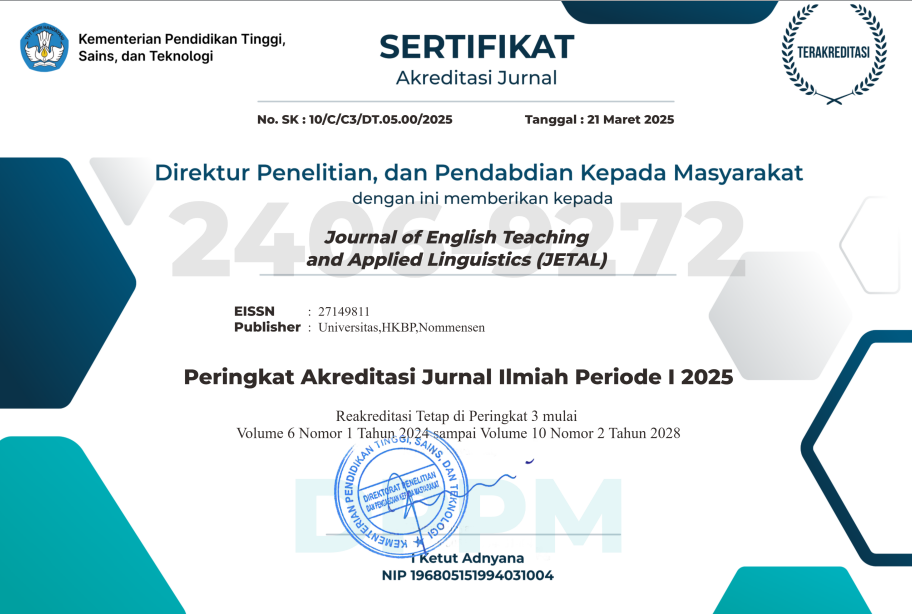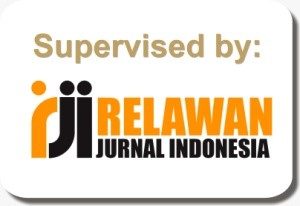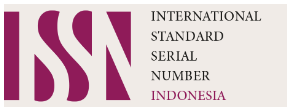EFFECTIVENESS OF INQUIRY BASED LEARNING METHOD TO INCREASE STUDENTS CRITICAL THINKING SPEAKING SKILL SMA PARULIAN 2 MEDAN
Abstract
This research isintended to find out Effectiveness of Inquiry Based Learning Method to Increase Students Critical Thinking Speaking Skill SMA Parulian 2 Medan. This research is conducted by applying Quantitative Experimental research. The sample of this research is two classes that consist 60 students which were selected by using random sampling technique. The first group is class XI MIA 2 (consist of 30 students) as a experimental class and class XI IPS 1 (consist of 30 students) as a control group. The instrument used for collecting the data is by giving the students speaking test. The test consist of pre-test, and post-test. The data was analyzed by using t-test formula in order to see wheter Inquiry Based Learning Method affects Students’ Speaking skill or not. The result of the analysis showed that t-observed is 4,43 higher than t-table 1,671 at level significance 0,05 with the degree of freedom 58. It means that alternative hypothesis (Ha) is accepted and null hypothesis (Ho) is rejected. Therefore there is significant affect of Inquiry Based Learning Method on Students’s Speaking Skill of Eleventh Grade at SMA Parulian 2 Medan. Therefore Inqury Based Learning Method can be applied by English Teacher in teaching speaking skill.
References
Ary, D., Jacobs, L.C., Sorensen, C., &Razavieh, A. (2010).Introduction toResearch in Education. Canada:Wadsworth.
Bailey & Turk. (2003). Critical Thinking: A Students Introduction. New York; McGraw-Hill.
Beebe, and Susan J, Beeebe. 1993. 2nd edition Public Speaking. United States:Prentice Hall.
Beyer. K. B, (1995) Critical Thinking. University of California. United States.
Bianchini&Coldburn. (2000). Creative Activities and Students Higher Order Thinking Skills. Education Journal.1(6).
Branch and Solowan. 2003. Inquiry Based Learning. Canadian Journal of Learning and Technology.
Brookfield, Stephen D& Brown.Developing Critical Thinkers. Jossey-Bass,1987.
Brown, H. D. (1994). Teaching by Principles: An Interactive Approach to Language Pedagogy. Englewood Cliffs, NJ: Prentice Hall Regent.
Ennis, Robert H. "A Taxonomy of Critical Thinking Disposition and Abilities."
In J.B. Baron and R. J. Sternberg (eds.), Teaching Thinking Skills: Theory and Practice 6(9). Freeman, 1987.
Friesen, S. 2009. Inquiry-based learning: Three Alberta schools that know what it takes. Education Canada, 14(8)
Friesen, S. 2012. Inquiry Based Learning. Unpublished paper, University of Harvard.
Folse, K. (2006). The Art of Teaching Speaking. Michigan: Michigan University Press.
Gerard. 2000. Languange Speaker. University of Tennessee-United States.
Guido, Marcus. 2017. Inquiry Based Learning for Critical. Universitas of Chicago. United States
Hairida, H. 2016. The Effectiveness Using Inquiry Based Natural Science Module with Authentic Assessment to Improve The Critical Thinking and Inquiry Skills of Junior High School Students. Indonesian Journal of Science Education.Vol.5(2).
Harmer (2001) The Effect of Inquiry-based Learning Method on Students Academic Achievement in Science Course.Universal Journal of Educational Research 2(1).
Haury, D. L. 1993. Teaching Science Through Inquiry. ERIC CSMEE Digest (March Ed 359-048).
Heaton.(1987) Students Ability in Speaking.University of Singapore.
Hwang & Chang. (2011). Overviews On Inquiry Based And Problem Based Learning Methods. Western Anatolia.Journal of Educational Sciences (WAJES).1(3).
Ismi (2018) The Generic Science Skill Profile of Fourth Grade Students on Acid and Base Topic in Guided Inquiry Learning Model at SMK Raja PermaisuriBainun. Scientific Journal of UniversitasNegeri Semarang.Vol.3(2).
Kahn (2006).The Effect of Communication Medium on Argumentation and the Development of Critical Thinking. International Journal of Educational Research, 23(4), 1364-1375.
Lucas, S. E (2009).The Art of Public Speaking 10th edition, New York:McGraw-Hill.
Lawson, S. 2010. IBL Critical Thinking and Problem Solving.Education for Students.Vol.15(5)
Parim. (2009). Guided Inquiry: A Framework for Learning Through School Libraries in 21st Century Schools. New Jersey: CISSL. (Online). http://cissl.scils.rutgers.edu/guided inquiry/introduction.-html.htm. on 20 July 2012.
Syakur (1987) Developing Classroom Speaking Activities: From Theory to Practice.
Turk (2003). Watson-Glaser Critical Thinking Appraisal manual.UAE.
Tseng, Tuan, & Chin. 2007. Inquiry Based Learning for Kids. Deboer Journal Research University of Taiwan.
Warsono and Hariyanto.2012. Inquiry Based Learning and Advantages &Disadvantages.University of Jakarta.
Webster. (2012) Truly Speech.Univeristy of New York, USA.
Authors retain copyright and grant the journal right of first publication with the work simultaneously licensed under a Creative Commons Attribution-ShareAlike 4.0 International License (CC BY-SA 4.0) that allows others to share the work with an acknowledgment of the work's authorship and initial publication in this journal.
Authors are able to enter into separate, additional contractual arrangements for the non-exclusive distribution of the journal's published version of the work (e.g., post it to an institutional repository or publish it in a book), with an acknowledgment of its initial publication in this journal.
Authors are permitted and encouraged to post their work online (e.g., in institutional repositories or on their website) prior to and during the submission process, as it can lead to productive exchanges, as well as earlier and greater citation of published work (See The Effect of Open Access).






